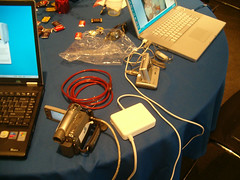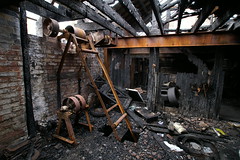Back when I taught high school, I was often in buildings that were fed by middle and elementary schools that did not hold art education in high esteem. This meant that I had to tailor my lessons to cover things most students learn in their K-8 years but make them interesting for a high school audience.
It also meant that I was able to make a list of things that, once I eventually taught elementary, would be able to drill into my students to prevent premature baldness and graying amongst the high school art teachers.
This list included the following five things:
 People are not sticks. (I don’t mind if a 3rd grader tries to draw a person and it doesn’t turn out, but a 3rd grader drawing a stick figure isn’t even trying.)
People are not sticks. (I don’t mind if a 3rd grader tries to draw a person and it doesn’t turn out, but a 3rd grader drawing a stick figure isn’t even trying.)- Trees are not lollipops.
- Not every tree has to have a hole in the trunk. (Honestly, half of them draw the holes so they’re wider than the trunks!)
- I’ve never seen a blue cloud in a white sky.
- Sky touches ground. (A blue bar at the top is … a blue bar at the top. Not a sky.)
Granted, I didn’t cover these things in every grade and every lesson. Not all students are developmentally able to comprehend my little list, and I still have room in my curriculum to do lessons that are more fun than they are nitpicky.
But at least by the time they leave elementary school all of my students know:
- A way to draw people that have at least enough mass to wear some clothes.
- A way to draw trees that are more accurate depictions than a circle (or green cloud) on a stick.
- That because it can exist on one thing does not mean it exists on everything.
- More than one way to make cool looking skies , including sunsets, storm clouds, and more.
- What a horizon line is.
My official curriculum is much more detailed than this, but I suppose these items are my “pet peeves,” if you will.
And this sort of got me thinking: Since I might become a technology teacher in a couple years, how will my list change? What are my technology pet peeves that I’ll feel I must cover, above and beyond the official standards?
I came up with something like this:
- Be safe! There are ways to be safe from online predators, stalkers, identity thieves, cyberbullies, and so on. Use them.
- Be creative! The great thing about the internet is that anyone can create content, including you!
- Be skeptical! The bad thing about the internet is that anyone can create content, including people who mislead others. Take the things you see online with a grain of salt.
- Be cautious! Also, what happens on the internet stays on the internet, but not in a good way. Anything digital can be copied and archived, as well as indexed for easy searching. Don’t put it online unless you want your mom, teacher, principal, significant others, and any future bosses to see it.
- Be clear! There media (PowerPoint, website, movie, etc.) should never be more important than the message it’s used to convey. Overworked and poorly designed projects can both keep people from remembering the very things you wanted them to learn.
Well, that’s my list, at least. What’s yours?



